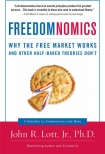Freedomnomics: Why the Free Market Works and Other Half-Baked Theories Don't John Jr. (the dot read aloud .txt) 📖

- Author: John Jr.
Book online «Freedomnomics: Why the Free Market Works and Other Half-Baked Theories Don't John Jr. (the dot read aloud .txt) 📖». Author John Jr.
58 Obtained via Bureau of Justice Statistics, Capital Punishment, 1985-2005, (http://www.ojp.usdoj.gov/bjs/pubalp2.htm#cp) and from FBI Uniform Crime Reports, 1976-2005, (http://www.ojp.usdoj.gov/bjs/homicide/tables/totalstab.htm).
59 Not all murderers are eligible for the death penalty. To qualify, murders must have either killed multiple victims, children, or law enforcement officers, or committed murder while committing another felony. The smaller group of criminals that meet this criteria face a 1 in 70 chance of being executed. From 1977 to 2003, about 25 percent of murders were eligible for the death penalty. This assumes that that ratio holds for 2005. See Jeffrey Fagan, Franklin E. Zimring, and Amanda Geller, “Capital Punishment and Capital Murder: Market Share and the Deterrent Effects of the Death Penalty,” Texas Law Review (June 2006): 1819.
60 Steven Levitt, “Understanding Why Crime Fell in the 1990s: Four Factors that Explain the Decline and Six that Do Not,” Journal of Economics Perspectives (2004): 175.
61 For more on the role played by risk in criminal behavior, see W. Kip Viscusi, “The Risks and Rewards of Criminal Activity: A Comprehensive Test of Criminal Deterrence,” Journal of Labor Economics (1986): 317-340, and Michael K. Block and Vernon E. Gerety, “Some Experimental Evidence on Differences Between Student and Prisoner Reactions to Monetary Penalties and Risk,” Journal of Legal Studies (January 1995): 123-138.
62 Raymond Bonner and Ford Fessenden, “States With No Death Penalty Share Lower Homicide Rates,” New York Times, September 22, 2000, A1.
63 These were Alaska, Hawaii, Iowa, Maine, Massachusetts, Michigan, Minnesota, North Dakota, Rhode Island, West Virginia, Wisconsin, and Vermont.
64 From 1977 to 1998, the population weighted drop in murder rates for the 12 states that never instituted the death penalty fell by 21 percent. For the 38 other states, their murder rate fell by 29 percent. Http://www.disaster-center.com/crime/uscrime.htm.
65 Some analysts inexplicably date the end of capital punishment to the 1972 Furman decision by the Supreme Court, even though executions had stopped in 1968. See John Donohue and Wolfers, “Uses and abuses of empirical evidence in the death penalty debate,” Stanford Law Review, 2006, 791-845. The graph I show uses the execution rate because it gives readers the best indication of the execution risk that criminals face by committing murder.
66 Paul G. Cassell and Richard Fowles, “Handcuffing the Cops? A Thirty-Year Perspective on Miranda’s Harmful Effects on Law Enforcement,” Stanford Law Review (April, 1998): 1055-1144. The Miranda decision may have affected crime rates, but it’s precise effect is difficult to evaluate; since it was a Supreme Court decision, we can only evaluate it through time-series data for the entire United States. Furthermore, there were so many other Supreme Court decisions as well as other possible explanatory factors that it is simply impossible to disentangle all of them.
67 The first serious cross-sectional tests using census data were in Isaac Ehrlich, “Capital Punishment and Deterrence: Some Further Thoughts and Additional Evidence,” Journal of Political Economy, August 1977. The first time-series estimates were in Isaac Ehrlich, “The Deterrent Effect of Capital Punishment,” American Economic Review, August 1975.
68 Isaac Ehrlich, “Capital Punishment and Deterrence: Some Further Thoughts and Additional Evidence,” Journal of Political Economy (August 1977): 779.
69 Committee on Research on Law Enforcement and Criminal Justice, Understanding Crime—An Evaluation of the National Institute of Law Enforcement and Criminal Justice (National Academy of Science, Susan White and Samuel Krislow editors, 1977). See also Alfred Blumstein, Jacqueline Cohen and Daniel Nagin, Deterrence and Incapacitation: Estimating the Effects of Criminal Sanctions on Crime Rates (Washington, D.C.: National Academy of Science, 1978). Ehrlich co-authored another study responding to the National Academic of Sciences report. See Isaac Ehrlich and Mark Randall, “Fear of Deterrence,” Journal of Legal Studies (1977): 293-316.
70 The few studies that fail to find any deterrence from the death penalty either don’t use all the data or measure the execution rate in strange ways. For example, ignoring data from individual states, Narayan and Smyth look only at national statistics through a data set that has only thirty-seven observations. Richard Berk, for his part, achieved his result by discarding data for entire states such as Texas. See Paresh Kumar Narayan and Russell Smyth, “Dead Man Walking: An Empirical Reassessment of the Deterrent Effect of Capital Punishment Using the Bounds Testing Approach to Cointegration,” Applied Economics, 2006, and Richard Berk, “New Claims about Executions and General Deterrence,” Journal of Empirical Legal Studies, 2005. Rather than analyzing the percent of murders that result in execution, some researchers measure the number of executions per prisoner. It is not clear why anyone would believe that if jails are filled up with additional prisoners convicted of crimes like drug possession or car theft, the risk murderers face from execution would decline. Comparing two unrelated statistics, it is hardly surprising that this research cannot identify any benefit from the death penalty. See Lawrence Katz, Steven Levitt, Ellen Shustorovish, “Prison Conditions, Capital Punishment, and Deterrence,” American Law and Economics Review, 2003, 318-343. Another paper by Donohue and Wolfers has used this approach uncritically. See John Donohue and Wolfers, “Uses and abuses of empirical evidence in the death penalty debate,” Stanford Law Review, 2006, 791-845.
71 My work with Bill Landes finds a much larger benefit—implying that each execution saves hundreds of lives. We found that each one percentage point in execution rates lowered the murder rate by at least four percent. Lott, The Bias Against Guns (2003), Chapter. 6.
72 Lott and Landes in Lott, The Bias Against Guns (Regnery 2003), Chapter 6.
73 Lott, More Guns, Less Crime (University of Chicago Press, 2000), Chapter 9.
74 Prison wardens face a similar problem. If a prisoner is sentenced to death, it’s





Comments (0)